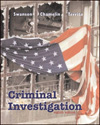 |  Criminal Investigation, 8/e Charles R. Swanson,
University of Georgia
Neil C. Chamelin,
Assistant State Attorney, Second Judicial Circuit
Leonard Territo,
University of South Florida- Tampa
What's New- A new Chapter 8, Investigative Resources, covers criminal intelligence units, the five-step intelligence cycle, analytical and investigative tools, crime analysis, types of crime analysis, crime bulletins, the internet as an investigative aid, social network analysis, e-mail and telephone toll analysis, geographic profiling, DNA databases, time/event charts, crime scene reconstruction, profiling, the National Crime Information Center (NCIC), and state and local databases.
- A new Chapter 2, Investigation, Investigators, and the Crime Scene, covers terrorist crime scenes, self-protection and investigative measures at biological and chemical attack crime scenes, the preliminary investigation, new neighborhood and vehicle canvassing forms, crime scene safety issues, and more.
- A new Chapter 21, Terrorism, covers domestic and foreign terrorism, terrorism goals, terrorist organizations, and the role of local law enforcement in investigating terrorism.
- Chapter 5, Field Notes and Investigative Reporting, has been substantially revised. New topics introduced include basic and primary questions, the use of mobile data terminals/laptops to generate reports, Uniform Crime reporting style incident reports versus National Incident Based reporting System (NIBRS) formats, and an expanded section on the importance of field notes and guidelines for the note-taking process.
- Other significantly updated chapters include Chapter 3, Physical Evidence (new information on electrostatic lifting of fingerprints); Chapter 6, Follow-Up Investigation (electronic surveillance, internal and external investigative sources); Chapter 9, Injury and Death Investigation (stalking, cyber stalking, serial murder); Chapter 10, Sex-Related Offenses (sexual murders, date rape drugs); Chapter 11, Crimes Against Children (runaways and adductions, sex offender registration, crime in schools); Chapter 14, Larceny and Fraud (mail fraud, use of the Internet to launder money, identity theft); Chapter 18, Arson and Explosives Investigations (bomb scene investigations, terrorism); Chapter 19, Drug Abuse (OxyContin and other 'new' drugs).
- New learning tools throughout -- chapter objectives, glossaries, detailed outlines, expanded introductions, and plentiful Internet activities -- make this edition of the text easier to learn from than ever.
|
|



 2002 McGraw-Hill Higher Education
2002 McGraw-Hill Higher Education

 2002 McGraw-Hill Higher Education
2002 McGraw-Hill Higher Education